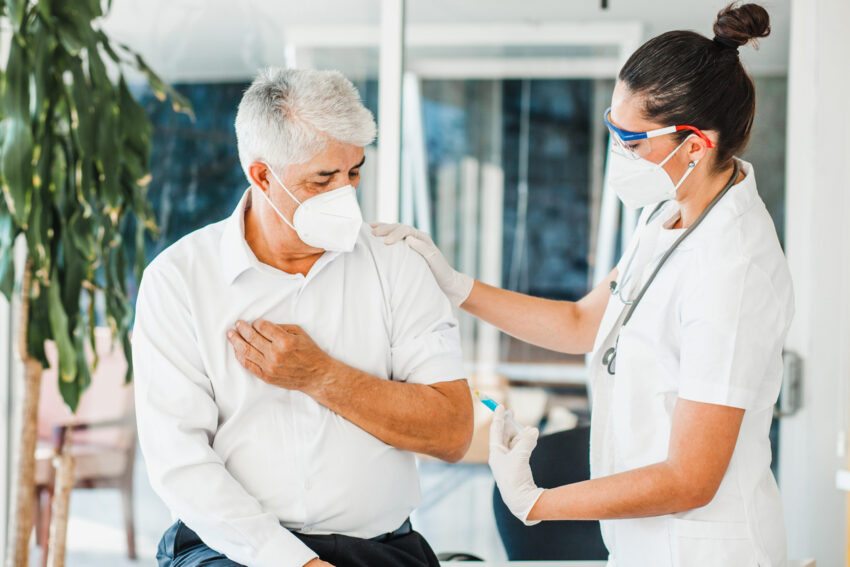
Share On Social!
The number of COVID-19 cases from the Omicron variant continues to rise.
Consistent with current understanding of the disease trajectory, the U.S. Centers for Disease Control and Prevention (CDC) is releasing updated guidance for isolation and quarantine for healthcare workers, decreasing their isolation time after infection with COVID-19.
Additionally, CDC is releasing an update to guidance for contingency and crisis management in the setting of significant healthcare worker shortages.
These updates provide healthcare facilities with strategies to limit the effects of staff shortages caused by COVID-19 on patient care and note that:
- Healthcare workers with COVID-19 who are asymptomatic can return to work after 7 days with a negative test, and that isolation time can be cut further if there are staffing shortages.
- Healthcare workers who have received all recommended COVID-19 vaccine doses, including a booster, do not need to quarantine at home following high-risk exposures.
“These guidelines apply only to the healthcare workforce and may be revised to continue to protect both healthcare workers and patients as additional information on the Omicron variant becomes available to inform recommended actions,” according to the CDC.
Let’s explore the updates for each of the guidance documents below.
CDC: Interim Guidance for Managing Healthcare Personnel with SARS-CoV-2 Infection or Exposure to SARS-CoV-2
Due to concerns about increased transmissibility of the SARS-CoV-2 Omicron variant, this guidance is being updated to enhance protection for healthcare personnel (HCP), patients, and visitors, and to address concerns about potential impacts on the healthcare system given a surge of SARS-CoV-2 infections.
These updates will be refined as additional information becomes available to inform recommended actions.
- Ensure that SARS-CoV-2 testing is performed with a test that is capable of detecting external icon SARS-CoV-2, even with currently circulating variants in the United States.
- Updated recommendations regarding when HCP with SARS-CoV-2 infection could return to work

- The definition of higher-risk exposure was updated to include use of a facemask (instead of a respirator) by HCP if the infected patient is not also wearing a facemask or cloth mask.
- Added options that would allow asymptomatic HCP with a higher-risk exposure who have not received all COVID-19 vaccine doses, including booster dose, as recommended by CDC to return to work prior to the previously recommended 14-day post-exposure period of work restriction, assuming they do not develop symptoms or test positive for SARS-CoV-2.
CDC: Strategies to Mitigate Healthcare Personnel Staffing Shortages
Due to concerns about increased transmissibility of the SARS-CoV-2 Omicron variant, this guidance is being updated to enhance protection for healthcare personnel (HCP), patients, and visitors and to address concerns about potential impacts on the healthcare system given a surge of SARS-CoV-2 infections.
These updates will be refined as additional information becomes available to inform recommended actions.
- Ensure that SARS-CoV-2 testing is performed with a test that is capable of detecting external icon SARS-CoV-2, even with the currently circulating variants in the United States.
- Updated contingency and crisis strategies for mitigating staff shortages.
- Maintaining appropriate staffing in healthcare facilities is essential to providing a safe work environment for HCP and for safe patient care.
- Maximizing interventions to protect HCP, patients, and visitors are critical at all times, including when considering strategies to address staffing shortages.
- CDC’s mitigation strategies offer a continuum of options for addressing staffing shortages. Contingency, followed by crisis capacity, strategies augment conventional strategies and are meant to be considered and implemented sequentially (i.e., implementing contingency strategies before crisis strategies).
Editor’s Note: This article is part of a collaboration between Salud America!, the National Hispanic Medical Association, and the CDC’s Project Firstline. To find resources training materials, and other tools to bolster knowledge and practice of infection control, visit Project Firstline and view Salud America!’s infection control content.
Explore More:
Infection ControlBy The Numbers
100
percent
of healthcare workers should focus on infection control



